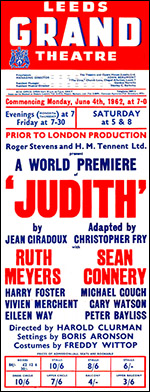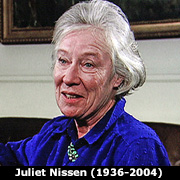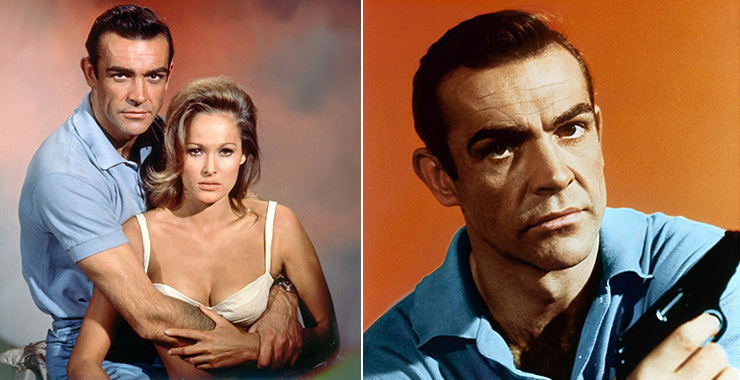 |
|
Shooting of the scenes in Doctor No’s apartment
began on March
13, 1962 where the first of the series’ many ‘in-jokes’
was filmed. As James Bond and Honey join Doctor No for dinner, Bond passes
a portrait of The Duke of Wellington by Francisco de Goya, and does a
subtle double-take when he realises the significance of the work of art.
The real-life painting had famously been stolen from the National Gallery
on August 12, 1961, and was still missing. The implication that Doctor
No was behind the robbery had a great audience reaction when the film was
first released in 1962. The circumstances behind the theft were later
dramatized in the 2021 comedy-drama film The Duke.
|
|
|
|
Sean Connery and Bob
Simmons then spent two days filming with the live tarantula. A Perspex
sheet protected the actor, with the stunt performer bravely allowing the
venomous arachnid to crawl across his body, with a little encouragement
from nervous crew members. Bob Simmons repeated the scene in EON
Productions next film Call Me Bwana (1963), this time doubling for
Bob Hope. The comedy film spoofed the Dr. No spider scene
[pictured
below], and the film itself was cross-promoted in From Russia With Love (1963)
– with a huge film poster seen on the exterior of assassin Krilencu’s
hideout as he emerges from a secret window behind Anita Ekberg’s mouth on
the poster. |
 |
|
ABOVE: (left) Sean
Connery with the model spider made by the props department for
publicity purposes, and later sold in auction at CHRISTIE'S for
£2,990 on September 17, 1998. (right) Stuntman Bob Simmons
repeated the spider scene in EON Productions next film, Call Me
Bwana (1963), this time doubling for Bob Hope. |
|
|
 |
“All the
World's A Stage...”
Before Dr. No was released and the role of James Bond
catapulted him to international stardom, Sean Connery was still a
jobbing actor. As soon as Connery had finished filming he returned
to the stage to appear in the world premiere production of
Judith. The play was written in 1931 by French dramatist Jean
Giraudoux, and set in ancient Palestine where an Assyrian army is
attacking a Jewish community. The Assyrians are led by Holofernes,
played by Sean Connery, with Ruth Meyers (1936-) as the title
character. Judith was adapted by English poet and
playwright Christopher Fry (1907-2005) - best known for his verse
dramas, especially The Lady's Not For Burning (1949).
Judith premiered at the Leeds Grand Theatre on Monday June
4, 1962, playing for one week and then transferred to Her
Majesty's Theatre, Haymarket in London's West End for a four-week
run. Opening in London on Wednesday June 20, 1962, Judith
was critically well-received, with Connery particularly singled
out and praised for his performance. As a relatively short
play Judith was performed twice-nightly. Also in the cast
were Barry Foster [mis-spelled Harry on the Leeds poster - pictured
left] (1931-2002) and Vivien Merchant (1929-1982) [also mis-spelled], who would both later appear in Alfred Hitchcock's
Frenzy (1972). Within a year of the production of Judith,
Sean Connery would star in the 1964 Alfred Hitchcock thriller
Marnie, filmed in America between the shooting of From
Russia With Love (1963) and Goldfinger (1964). A decade
after appearing together on stage in Judith, Sean Connery
and Vivien Merchant would be reunited to play husband and wife in
Sidney Lumet's The
Offence (1972) - this gritty drama gave Connery what was
arguably his best on-screen performance as police
Detective-Sergeant Johnson, who kills suspected child molester
Kenneth Baxter (Ian Bannen) whilst under interrogation. Judith
would be Sean Connery's final role on stage. |
|
|
Also in the cast of
Judith was English actor
Peter Bayliss
(1922-2002) who would later play Russian Commissar Benz in From
Russia With Love (1963) - sharing a scene with Sean Connery and
Pedro Armendariz
aboard the Orient Express. Another young actor appearing in Judith
was Michael Culver (1938-2024), who
would appear in small roles [uncredited] in From Russia With Love
(1963) and Thunderball (1965). |
|
|
|
|
After reviewing a rough
cut of Dr. No, director Terence Young ordered several pick-ups,
reaction shots and inserts that were then filmed on April 26, 1962.
Also on the final day of shooting, the model of Crab Key was blown up
in the Pinewood Paddock Tank at a cost of £1,000. During post-production editor Peter Hunt
also oversaw the re-voicing of many of the vocal performances in the film.
As a consequence of her heavy Swiss/German accent, Ursula Andress was
totally re-voiced by
Monica ‘Nikki’ van der Zyl, who also provided the
voice of Eunice Gayson. EON Productions progress reports reveal the names
of the
other artistes used for the post-synching sessions in April 1962. Terence Young’s daughter Juliet Nissen (1936-2004)
re-voiced
Dolores Keator (Strangways’ secretary Mary), and Marguerite LeWars, who
played the un-named freelance Girl Photographer.
|
 |
|
|
Other smaller roles were
re-dubbed by
Robert Rietty, who along with Nikki van
der Zyl would return to the series in subsequent films, finally appearing
onscreen himself in On Her Majesty's Secret Service (1969). Trinidadian born stage and screen actor Frank Singuineau (1913-1992), who
appeared uncredited as the waiter in Bond’s hotel room, and
serves the series’ first vodka martini (shaken not stirred!), also
provided voices for other small roles in Dr. No, including the three
blind beggars in the opening of the film. British supporting actor Harry
Locke provided the voice for General Potter (credited as Col. Burton in
the film) and Decontamination and Reactor Room voices, as did Maxwell Shaw
(1929-1985) [who appeared uncredited in the film as 2nd Radio Operator]
who also re-voiced other actors including one the Crab Key guards.
The contracts for most of the principal artistes cast
in Dr. No permitted the substitution of their voice by another
person in the final release version. As much of the film
was shot on location in Jamaica, it was not cost-effective to have these
artistes flown over to London for the post-synching sessions, and explains
why so many performances were so expertly re-voiced. |
|
|
|
It also became apparent
during the sound editing stage that Monty Norman had not provided a
satisfactory theme for the character of James Bond. Co-producer Harry
Saltzman had suggested putting ‘Under The Mango Tree’ as the title music,
but others felt the film needed a more contemporary non-Jamaican theme,
and it was proposed that popular band leader and arranger John Barry be
brought in to provide a new piece. Using very little of Monty Norman’s
original “Bad Sign, Good Sign” from an unproduced musical based on V.S. Naipaul’s acclaimed novel A House For Mr. Biswas, Barry was given a very
short amount of time to come up with what ultimately became ‘The James
Bond Theme’. Recorded for the first time at Cine-Tele Sound (CTS) Studios
in Bayswater on Thursday June 21, 1962, John Barry’s arrangement of ‘The
James Bond Theme’ has since become one of the most famous and instantly
recognisable pieces of music ever conceived and recorded. Editor Peter
Hunt was so happy with the end result that he chose to use fragments of
the theme on the soundtrack throughout the film, much to the surprise and
chagrin of John Barry, who believed his arrangement was only going to be
used over the main titles. Barry received £200 for his first contribution
to the James Bond film series, with guitarist Vic Flick (1937-2024) being paid £7/10
shillings for his work. |
![Diana Coupland (1928-2006) with her husband composer Monty Norman (1928-2022) and actor John Kitzmiller [Quarrel in Dr. No] (1913-1965) at London Airport as they prepare to fly to Jamaica for the filming of Dr. No.| John Barry](dn60/monty_norman-john_barry.jpg) |
|
ABOVE (left) Sunday
January 14, 1962 - Actress & singer Diana Coupland (1928-2006)
with her husband composer Monty Norman (1928-2022) and actor John
Kitzmiller [Quarrel in Dr. No] (1913-1965) at London
Airport as they prepare to fly to Jamaica for the filming of
Dr. No. (right) Band leader and composer John Barry
(1933-2010) who would memorably arrange and perform (with his band
The John Barry Seven) ‘The James Bond Theme’ heard throughout
Dr. No (1962). Diana Coupland recorded the version of ‘Under
The Mango Tree’ heard on a record in Miss Taro's bungalow as James
Bond (Sean Connery) waits for Professor Dent (Anthony Dawson).
Although Monty Norman would compose the orchestral score for
Dr. No, it was John Barry who went on to score 11 subsequent
James Bond film soundtracks. |
|
|
|
Although Monty Norman was
very satisfied with John Barry’s definitive arrangement, he was less happy
with Maurice Binder’s choice to truncate and re-edit the piece for the
main titles of Dr. No. The first sound actually heard in the title before
James Bond fires his gun (Bob Simmons in the gun barrel sequence), is a
fifteen-second fragment of ‘Atoms in Space’ by electronic music pioneer
Daphne Oram (1925-2008). A second Oram piece was used as a sound effect by
dubbing editor Norman Wanstall, as Bond (Sean Connery) is moving through
the ventilation shafts and control room of Doctor No’s lair. The remainder
of the orchestral score was recorded the following week on June 25-26,
1962;
this time at Denham Film Studios with Burt Rhodes orchestrating Monty
Norman’s cues, and Eric Rogers conducting the orchestra.
John Barry's own
version of ‘The James Bond Theme’ was recorded on July 23, 1962, once
again with ‘The John Barry Seven’ member Vic Flick on guitar. The
re-recording runs slightly longer than the film version and has a
different orchestration. John Barry released his version as a single on
November 1, 1962, which spent 11 weeks in the UK charts peaking at
number 13 - his most successful single in two years. |
 |
|
CONTINUED
>> |

|

